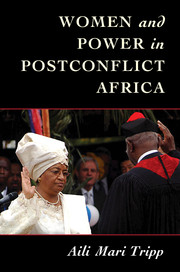Book contents
- Frontmatter
- Epigraph
- Dedication
- Contents
- List of Tables
- List of Figures
- Map of Africa
- List of Acronyms
- Acknowledgments
- Preface
- Part I Setting the Stage
- Part II Case Studies
- Part III New Openings for Women's Rights
- Part IV Gendered Outcomes
- 8 Women and Leadership in Postconflict Countries
- 9 Women's Rights and Postconflict Legislative Reform
- Part V Future Research
- References
- Index
9 - Women's Rights and Postconflict Legislative Reform
from Part IV - Gendered Outcomes
Published online by Cambridge University Press: 05 November 2015
- Frontmatter
- Epigraph
- Dedication
- Contents
- List of Tables
- List of Figures
- Map of Africa
- List of Acronyms
- Acknowledgments
- Preface
- Part I Setting the Stage
- Part II Case Studies
- Part III New Openings for Women's Rights
- Part IV Gendered Outcomes
- 8 Women and Leadership in Postconflict Countries
- 9 Women's Rights and Postconflict Legislative Reform
- Part V Future Research
- References
- Index
Summary
As long as we take the view that these are problems for women alone to solve, we cannot expect to reverse the high incidence of rape and child abuse. Domestic violence will not be eradicated. We will not defeat this scourge that affects each and every one of us, until we succeed in mobilizing the whole of our society to fight it.
– Nelson MandelaPrevious chapters looked at two key opportunity structures or transitional processes that women's rights activists sought to influence: peace negotiations and constitution-making exercises. The outcomes of these processes included peace agreements (Chapter 6) and revised constitutions (Chapter 7) that incorporated provisions for increased women's representation and stronger women's rights. These paved the way for legislative changes and other policy reforms affecting women's rights. The main areas of legislative reform influencing women in postconflict contexts have been in the areas of violence against women, family law, land, and quotas to promote women's representation in legislatures and other bodies, which was already discussed in Chapter 8. This chapter looks at legislation around women's rights in the areas of gender-based violence and family law and discusses some of the challenges in focusing on legal solutions in postconflict contexts.
As with constitutional changes, there are large differences between countries that have experienced major conflict and those that have not when it comes to legislative reform. This was already evident in the Chapter 8 discussion of quota law adoption, where we saw that 76 percent of postconflict countries had adopted quotas while only 58 percent of nonconflict countries had done so. After the 1990s, women's rights activists in postconflict countries were beginning to see many of their aspirations for greater rights addressed through the passage of legislation. In discussing legislation as an outcome of the processes described in this book, there is no assumption that once legislation is enacted that it is always enforced or that it radically changes women's lives. However, it does establish the normative ground rules for society and what is regarded as acceptable societal practices and behavior. It creates the legal basis from which women can demand their rights and enforce change. Thus, these legal changes are a way of measuring where a society stands in relation to women's rights, but they are insufficient as a measure of their actual impact on women's lives.
- Type
- Chapter
- Information
- Women and Power in Postconflict Africa , pp. 218 - 232Publisher: Cambridge University PressPrint publication year: 2015



